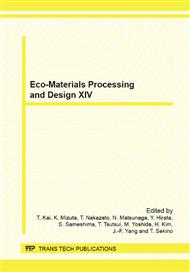[1]
A. Fujishima, K. Honda, Electrochemical photolysis of water at a semiconductor electrode, Nature 238 (1972) 37–38.
DOI: 10.1038/238037a0
Google Scholar
[2]
T. Ibusuki, K. Takeuchi, Removal of low concentration nitrogen oxides through photoassisted heterogeneous catalysis, J. Mol. Catal. 88 (1994) 93–102.
DOI: 10.1016/0304-5102(93)e0247-e
Google Scholar
[3]
M. R. Hoffmann, S.T. Martin, W.Y. Choi, D.W. Bahnemann, Environmental applications of semiconductor photocatalysis, Chem. Rev. 95 (1995) 69–96.
DOI: 10.1021/cr00033a004
Google Scholar
[4]
A. Fujishima, N.R. Tata, A.T. Donald, Titanium dioxide photocatalysis, J. Photochem. Photobiol. C: Photochem. Rev. 1 (2000) 1–21.
Google Scholar
[5]
R. Asahi, T. Morikawa, T. Ohwaki, K. Aoki, Y., Taga, Visible-light photocatalysis in nitrogen-doped titanium dioxide, Science 293 (2001) 269–271.
DOI: 10.1126/science.1061051
Google Scholar
[6]
A., Fujishima, X. Zhang, D.A. Tryk, TiO2 photocatalysis and related surface phenomena, Surf. Sci. Rep. 63 (2008) 515–582.
DOI: 10.1016/j.surfrep.2008.10.001
Google Scholar
[7]
A.V., Emeline, V.N., Kuznetsov, V.K., Rybchuk, N. Serpone, Visible-light-active titania photocatalysts: The case of N-doped TiO2s-properties and some fundamental issues, Int. J. Photoenergy 2008 (2008) 258394.
DOI: 10.1155/2008/258394
Google Scholar
[8]
M. Pelaez, N.T. Nolan, S.C. Pillai, M.K. Seery, P. Falaras, A.G. Kontos, P.S.M. Dunlop, J.W.J. Hamilton, J. Byrne, K. O'Shea, M.H. Entezari, D.D. Dionysiou, A review on the visible light active titanium dioxide photocatalysts for environmental applications. Appl. Catal. B: Environ. 125 (2012) 331–349.
DOI: 10.1016/j.apcatb.2012.05.036
Google Scholar
[9]
C. Di Valentin, G. Pacchioni, A. Selloni, S. Livraghi, E. Giamello, Characterization of paramagnetic species in N-doped TiO2 powders by EPR spectroscopy and DFT calculations, J. Phys. Chem. B 109 (2005), 11414–11419.
DOI: 10.1021/jp051756t
Google Scholar
[10]
J. Wang, D.N. Tafen, J.P. Lewis, Z. Hong, A. Manivannan, M. Zhi, M. Li, N. Wu, Origin of photocatalytic activity of nitrogen-doped TiO2 nanobelts, J. Am. Chem. Soc. 131 (2009) 12290–12297.
DOI: 10.1021/ja903781h
Google Scholar
[11]
Y. Aita, M. Komatsu, S. Yin, T. Sato, Phase-compositional control and visible light photocatalytic activity of nitrogen-doped titania via solvothermal process, J. Solid State Chem., 177 (2004) 3235–3238.
DOI: 10.1016/j.jssc.2004.04.048
Google Scholar
[12]
F. Peng, L. Cai, L. Huang, H. Yu, H. Wang, Preparation of nitrogen-doped titanium dioxide with visible-light photocatalytic activity using a facile hydrothermal method, Phys. Chem. Solids, 69 (2008) 1657–1664.
DOI: 10.1016/j.jpcs.2007.12.003
Google Scholar
[13]
M. D'Arienzo, R. Scotti, L. Wahba, C. Battochhio, E. Bemporad, A. Nale, F. Morazzoni, Hydrothermal N-doped TiO2: Explaining photocatalytic properties by electronic and magnetic identification of N active sites, Appl. Catal., B, 93 (2009) 149–155.
DOI: 10.1016/j.apcatb.2009.09.024
Google Scholar
[14]
X. Wang, T.-T. Lim, Effect of hexamethylenetetramine on the visible-light photocatalytic activity of C–N codoped TiO2 for bisphenol A degradation: evaluation of photocatalytic mechanism and solution toxicity, Appl. Catal., A, 399 (2011) 233–241.
DOI: 10.1016/j.apcata.2011.04.002
Google Scholar
[15]
C.-C. Hu, T.-C. Hsu, L.-H. Kao, One-step cohydrothermal synthesis of nitrogen-doped titanium oxide nanotubes with enhanced visible light photocatalytic activity, Int. J. Photoenergy, 2012 (2012) Article ID 391958.
DOI: 10.1155/2012/391958
Google Scholar


